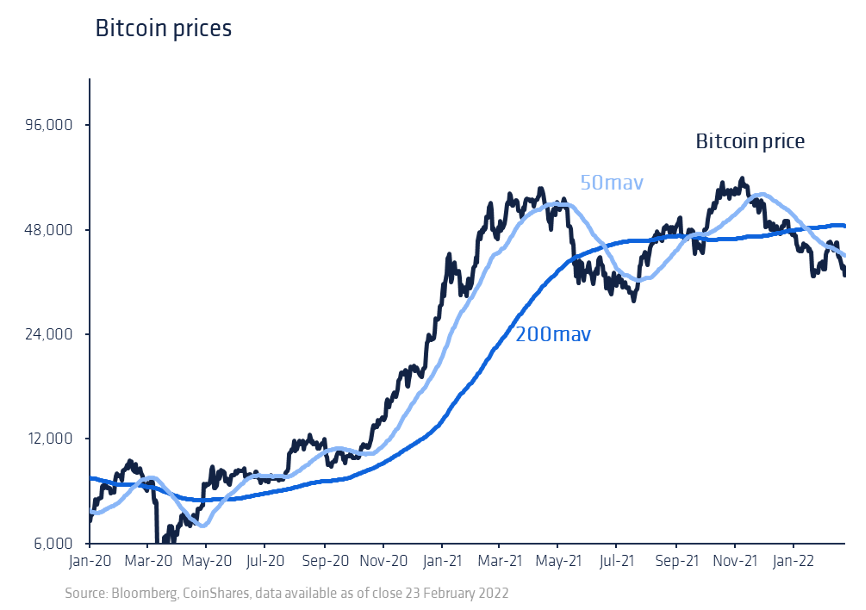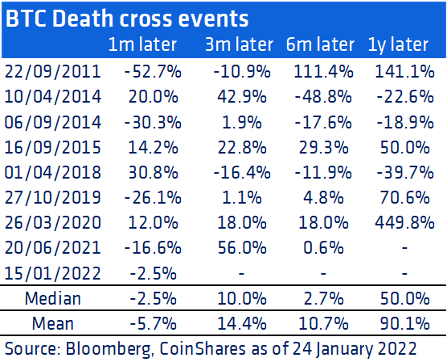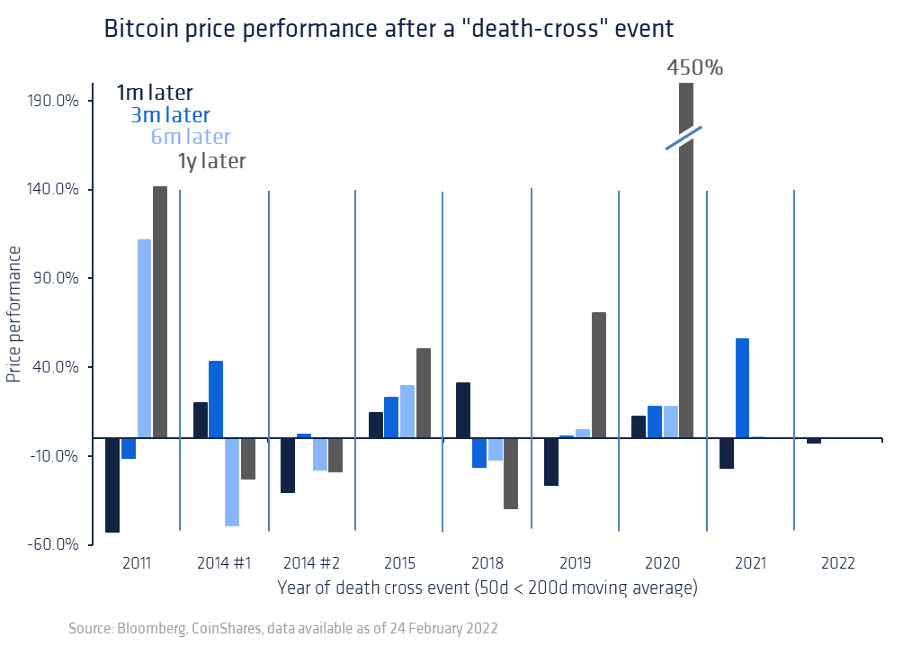Bitcoin had an immediate response to the Ukraine invasion when the news broke early Thursday morning. It has become evident that, at present, Bitcoin is behaving as a risk asset, with prices dropping below the technical resistance levels of the 50 day and 200 day moving averages.
This has been a perfect storm for Bitcoin, through the combined threats of interest rate hikes across the major economies, numerous regulatory proposals, and now geopolitical instability in Europe shaking global markets, pushing Bitcoin prices down by 23% year-to-date. Yet again however, we don’t believe this changes the long-term supportive fundamentals.

Bitcoin’s fluid identity
We know that Bitcoin’s identity, i.e. the predominant narrative driving prices at any given time, remains very fluid. At present the narrative is being driven by risk and interest rate-sensitive speculators and Bitcoin is now moving similarly to other risk assets. This does not detract from its properties as a real asset.
It is clear to us that Bitcoin is still in a process of establishing its identity and this is a process that could take decades. It is reasonable to assume that, during this period, different people will use Bitcoin for different purposes, based on their own needs and the monetary properties offered by Bitcoin.
Some of Bitcoin’s fixed properties such as its limited supply and confiscation resistance, makes it highly suitable as a safe haven asset over the long term. This does not however mean that everyone will use it for that at any and all times. Any freely available asset with many beneficial properties will see different users using it for different purposes.
While some users are likely using it as a long-term store of value and safe haven asset right now, many other users may not. And at the end of the day, what we’re probably seeing now is a signal of the proportions of current users using it as long-term savings and safe haven, versus users using it as an object of financial speculation.
While Bitcoin remains in its monetisation phase, it is not strange to expect speculators to be heavily involved in trading and liquidity provision, and they will not necessarily use Bitcoin for any of the uses its properties make it best suited. They will likely use it way more as a risk asset than a safe haven as they are in the business of making money on taking risks on its future adoption as global money.
Bitcoin – the stateless asset, a double-edged sword
Hiding in the reeds here are some other major macro events that are highly favourable to future Bitcoin adoption. As a perfect example, right this moment we are witnessing the Trudeau regime weaponise the Canadian banking system against its own citizens.
This is a brutal and surprising demonstration to millions of people that even in supposed liberal Western democracies, the domestic political situation can rapidly deteriorate to the point where constitutional protections of individuals are suspended and governments co-opt banks to attack their political enemies. Having a separation of money and state is clearly in the benefit of the citizenry in situations like this.
But Bitcoin being a fully independent stateless asset is of course a double-edged sword. If anyone can freely access a monetary system, that means your enemies can too. Under a global order that is substantially enforced using the dollar-based global monetary system as a major tool in the diplomatic toolkit, the ability for unfriendly states to access alternative monetary rails is a problem.
One wonders if the invasion is the first hard signal that the sanctions-era of political pressure is over. If a leader like Putin will, even under the threat of the strictest possible sanctions, still invade another sovereign nation, what power do sanctions still have?
Monetary game theory also seems unfavourable for the Western powers. Having used sanctions rather liberally over the past few decades, its geopolitical opponents have naturally searched for workarounds. It is not hard to imagine that, at some point, the constant sanction costs of participating in the dollar-based global monetary system will outweigh the costs of ditching it completely. The harder sanctions are put on a nation, the sooner this flip will occur. The Central Bank of Russia is quite advanced in its work on the practical implementation of a digital ruble.
Western powers now need to thread a seemingly impossibly fine line: Apply sanctions too loosely, and Russia will ignore them, gauging their costs insufficient to outweigh the benefits of invasion. Apply sanctions too strongly, and Russia may judge participation in the dollar-based monetary order itself as too costly and seek out an alternative.
If that happens, not only would it severely blunt the future power of the sanctions toolkit, but it would weaken the global network effect of the US dollar itself, lowering its usefulness and therefore value as mone
Bitcoin and mining to circumvent sanctions?
Iran is a good example where sanctions on oil exports were circumvented by selling its energy reserves on the global markets, effectively using Bitcoin mining to bypass trade embargoes. Elliptic estimated that around 4% of total Iranian oil exports in 2020 could have been derived from Bitcoin mining. However, it remains debatable whether Bitcoin’s use to circumvent sanctions can be implemented in a meaningful way.
Should they wish to do so, Russia does have the energy resources and mining power under their control to pursue a similar strategy. According to our research, as of the end of December 2021, ~6.8% of global Bitcoin mining operations were located within Russia itself, and another ~8.2% were located in Kazakhstan—effectively a Russian client state.
Given the abundance of cheap energy available in Russia, using mining as an alternative revenue stream for energy resources is an entirely plausible scenario. At current Bitcoin prices of ~$35,000 the combined hashpower of Russia and Kazakhstan will generate an annual income of $1.7bn—not enough to offset the likely costs of sanctions, but also not nothing and probably enough to do some crucial business with willing counterparties.
Is this price weakness an opportunity?
Recent price weakness precipitated the infamous “death-cross” on 15 January 2022, which is often construed as a negative omen for future price movements. Our analysis highlights that these price weak points related to the “death-cross” have typically been buying opportunities rather than a point at which to sell-out, with median returns after the death cross event being 50% a year following the event.

Interestingly, while the price response to the Ukraine crisis was negative, we have not seen the intraday lows of $33,000 set on 24 January 2022.

Bitcoin has endured the perfect price storm recently, but it is worth noting that it is a young asset with a fluid identity, and that at present it is being dominated by risk-off speculation. There remains a core group of investors who continue to see the long-term potential of Bitcoin as an inflationary (real) asset, who also see the benefits of a stateless asset and a hedge against monetary policy failure, as evidenced by continued fund inflows.
Further commodity inflation caused by the Ukraine conflict poses a real dilemma for central bankers who are trying to maintain stable markets and low employment. Bitcoin’s fundamentals haven't changed, and on balance, we believe this recent price weakness represents a longer term opportunity rather than a point to flee.




